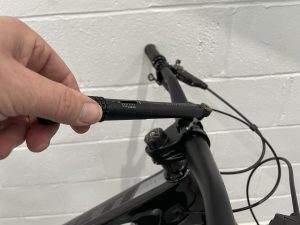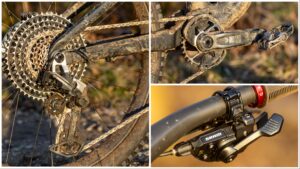Specialized Camber 29 review
2013 was the Specialized Camber 29’s second year of production, but there were already a raft of changes since its launch, the main one being that the entry-level model starts at £1,500 instead of two grand.
Frame
We were impressed with the performance of the original Specialized Camber 29 frame design, but it’s hardly surprising that a company whose motto is “innovate or die” was keen to keep making improvements. The frame has been stiffened up with revised tubing profiles and a co-pivot shock linkage, which also eliminates friction from the suspension for better small-bump sensitivity. Another big advantage of the new layout is the extra standover clearance; it’s a full 25mm lower than the next lowest bike on test, the Felt Edict Nine 60, and there’s still space for a water bottle, even on the smaller frame sizes. Another nice detail is the moulded chainstay protector to reduce chain slap, where the gear cable is routed inside the chainstay to stop it getting chewed up. All in, it’s a very polished design.
Suspension
There’s no point in having clever suspension linkages if you are struggling to set it up, and that’s where Specialized’s AutoSag technology on the RockShox rear shock comes into its own. Overinflate the shock, sit on the bike, then push the AutoSag button and the spring rate is set perfectly for your weight. Genius! Up front, the somewhat spindly XC30 fork isn’t air sprung, but it does get a size-specific spring, so our large bike came fitted with a firm coil. Still, it’s a black mark on the Camber’s score card when all of the other bikes in the test get lighter and more adjustable air-sprung forks.
Wheels
Specialized uses oversized end caps on the front hub to increase the contact area with the fork dropouts and boost stiffness, but we’d still like to see a proper oversized 15mm QR. Hub bearings are satin smooth front and rear, and Specialized has improved the reliability of the freehub so both hubs should easily outlast the rims.
Groupset
With bigger rotors than the Tektro brakes also found on the Felt, we had no issues keeping the Specialized Camber’s runaway speed in check. The rust-coloured nine-speed cassette looks cheap, and overall the drivetrain isn’t on a par with the Giant Trance X29er 2 or Cube AMS 120 29. It all works perfectly, it’s just not as good value.
Components
Specialized always gets the contact points dialled, and the £1,500 Specialized Camber is no exception. Even better, the basic quick-release seat collar, without the brass cam, was still super-smooth on the fifth ride.
Performance
The Specialized Camber has the roomiest cockpit of the four bikes in this test, but that’s not to say it has a head-down, butt-up riding position. The handlebar is easily high enough to take the weight off your lower back and still load the front tyre for cornering grip. Also, with ample standover clearance you never feel like you’re perched on a bike that’s a bit of a handful, even though the extra length really aids stability. Swapping the stock 90mm stem for a 70mm allowed us to open up the taps further on the Camber, making it even more apparent that rear suspension strikes a great balance between support for cornering and pedalling, but is still sensitive enough to iron out the rough stuff. And, even though it has less travel than the Cube AMS 120 29, the rear end was noticeably more planted, especially under braking. Unfortunately the front fork isn’t quite the measure of the rear, both in terms of travel and control.
>>> Click here to find out more about geometry with our handy guide
Verdict
Specialized has got the fundamentals sorted on the new Camber: the frame geometry and handling are great, the rear suspension punches well above its stated 110mm, and all of the components work well as a package. That said, we couldn’t help feel there’s a problem with pricing. Yes, the frame and shock are arguably the best in the test, but the 100mm-travel coil-sprung fork and low-end drivetrain don’t really capitalise on the short-travel, shred-everything attitude. Next to the Giant, you just can’t help feeling a little short-changed.
MBR rating: 8
Specification
Frame M5 aluminium, 110mm travel
Shock RockShox Monarch RL with AutoSag
Fork RockShox XC30 TK coil 100mm travel
Wheels Specialized HiLo hubs, Camber rims, Ground Control 2.3/2.1in tyres
Brakes Tektro Draco II 200/180 (L/XL)
Drivetrain Shimano Alivio chainset/shifters, SLX f-mech, Deore r-mech
Components Specialized
Sizes S, M, L, XL
Weight 14.6kg (32.2lb)
Contact specialized.com
Angle finder
Size tested L
Head angle 70.2°
Seat angle 69.8°
BB height 330mm
Chainstay 453mm
Front centre 711mm
Wheelbase 1,164mm
Down tube 710mm
This test appeared in the July 2013 issue of MBR, alongside the Cube AMS 120 29, Felt Edict Nine 60 and the Giant Trance X29er 2.
















